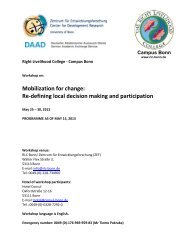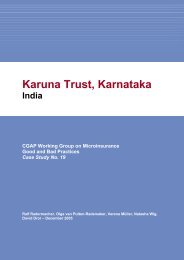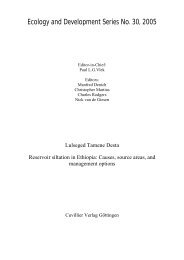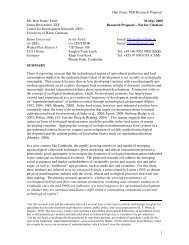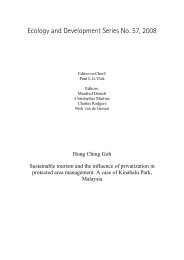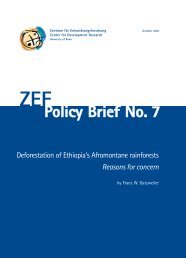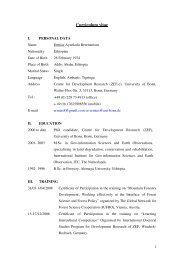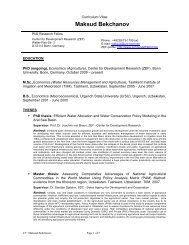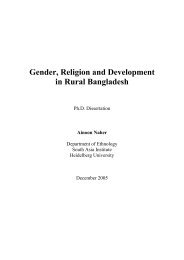Ecology and Development Series No. 10, 2003 - ZEF
Ecology and Development Series No. 10, 2003 - ZEF
Ecology and Development Series No. 10, 2003 - ZEF
- No tags were found...
You also want an ePaper? Increase the reach of your titles
YUMPU automatically turns print PDFs into web optimized ePapers that Google loves.
General introductionoutbreaks <strong>and</strong> environmental stresses. This warrants the need to conserve the diverse coffeegene pools in Ethiopia.Several studies have shown that the populations of C. arabica from thesouthwestern part of Ethiopia have high genetic variability, <strong>and</strong> the forests there are thussuitable for in situ conservation of the species. For example, Sylvian (1955, 1958) <strong>and</strong>Meyer (1968) observed a high diversity of several phenotypic characters among theEthiopian coffee populations. Montagnon <strong>and</strong> Bouharmont (1996) also found higherphenotypic diversity among the populations of C. arabica collected from Ethiopia ascompared to cultivated populations of the species from around the world. Recent analysesof C. arabica genetic diversity using molecular markers (Lashermes et al. 1996; Anthony etal. 2002; Steiger et al. 2002) revealed the presence of high genetic variability among theEthiopian coffee populations. The investigators used the accessions collected by the FAO<strong>and</strong> ORSTOM, which they described as ‘subspontaneous-derived accessions’, since theiridentity is not known for certain. However, the majority of the collections of FAO <strong>and</strong>ORSTOM in the 1960s from southwestern Ethiopia were from wild populations <strong>and</strong> somefrom naturalized populations (Meyer 1968; Charrier <strong>and</strong> Berthaud 1988). The latter mighthave originated from cultivars. It is assumed that most of the ‘subspontaneous-derivedaccessions’ are of wild origin. However, it is not clear how many originate from cultivars<strong>and</strong> how many from the wild plants, as both the wild <strong>and</strong> cultivated plants occur insouthwestern Ethiopia. What is certain is that the populations from southwestern Ethiopiahave a higher level of genetic diversity compared to the widely grown cultivars throughoutthe world. The cultivated coffee growing outside Ethiopia originates from two main lines ofcultivars: C. arabica var. typica Cramer <strong>and</strong> C. arabica var. bourbon (B. Rodr.) Choussy(Lashermes et al. 1996; Anthony et al. 2002). Many researchers have confirmed thatEthiopia is definitely the center of origin for C. arabica (Vavilov 1951; Harlan 1969;Engels <strong>and</strong> Hawkes 1991). The presence of the coffee plants of different stages ofdomestication <strong>and</strong> the availability of high genetic variability in southwestern Ethiopia leadto the hypothesis that the montane rain forest in this region is the center of origin where C.arabica first evolved within Ethiopia. Wild populations of the species still occur in severalmontane forests in SW Ethiopia, which are isolated from each other due to deforestation.3



